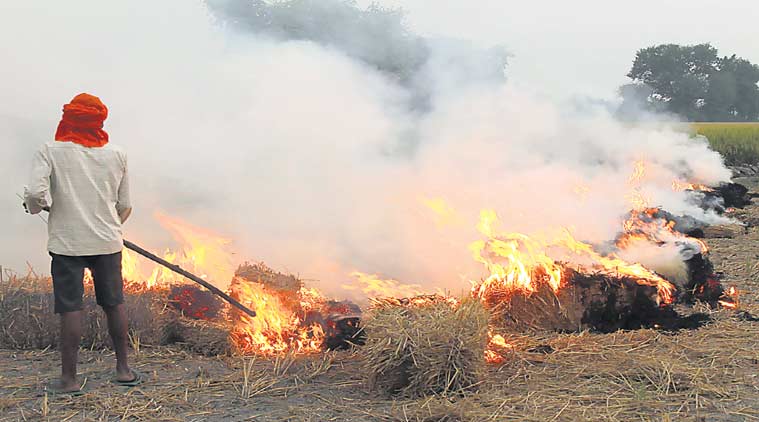The people of Delhi woke up on Friday last week (a day after Diwali) to the smoggiest morning of the year. The air was irritating, and one could feel the pain of being a Delhiite. Mainstream media jumped on the opportunity and blamed the Deepawali festivities for the spike in pollution levels and the national capital’s air quality index. NDTV, for example, said, “The Delhi air quality index reading plummeted to “severe” category this morning, following the festival of Diwali as people violated the ban on firecrackers and the national capital woke up under a blanket of toxic smog.” The concentrations of Particulate Matter (PM) 2.5 stood at 999 per cubic metre at Jawaharlal Nehru stadium in the city on Friday morning. What the media did not tell its audience though, is the fact that farmers from neighbouring states like Punjab and Haryana burnt stubble on Diwali like there was no tomorrow.
In Punjab especially, farmers were particularly indifferent to the woes of the people of the national capital region, as they took to stubble burning on a festive day knowing very well they would not be pulled up on Diwali and the day after it.
Stubble Burning on Diwali
According to the Times of India, stubble burning cases broke all records in the ongoing paddy harvesting season as Punjab reported 5,327 incidents in a day on Friday, taking the count to 28,792. Punjab had detected 3,032 cases on Diwali. It was the third time that over 3,000 straw burning events have been recorded in a day, with the earlier one being on November 2 at 3,001.
According to the Hindustan Times, the number of farm fires thus far this year, at 23465, is still almost half of 44086 cases reported for the corresponding period (till November 4) last year, but most officials expect it to increase over the coming week. There is data to suggest that stubble burning is only picking up pace, with 55% of all stubble burning this year being reported in the past five days. In Punjab, the highest number of farm fires on Diwali were reported from Ludhiana, which saw 292 cases. Sangrur recorded 283 while neighbouring Barnala recorded 237. Meanwhile, Ferozpur recorded 278 cases.
Two days after Diwali, the festive season for Punjab’s farmers was just getting started – as, 3,942 stubble burning cases were recorded on Saturday.
AQI Was Predicted to Hit the Sky Due to Stubble Burning
Interestingly, what the media failed to tell people was that in a report by the System of Air Quality and Weather Forecasting And Research (SAFAR) – it had been already predicted that due to winds coming from the northwest of Delhi, the number of pollutants entering Delhi from the burning farmlands will go up significantly on Friday and Saturday. The SAFAR report had said that the share of stubble burning on Delhi’s air pollution will go up from 8% to 20% on Wednesday and will go up to 35-45% on Friday and Saturday.
Meanwhile, Swarajya Magazine editor Arihant Pawariya on November 4 put out a tweet that provided insight into the mindset of these farmers whose actions have led to the people of India’s national capital choking. Pawariya asked a farmer why they were burning stubble during Diwali, to which the farmer in question replied saying that nobody will catch them as it is the time of festivals.
Full on stubble burning today. Asked a farmer why they are doing it specifically on Diwali, ‘aaj tyohar hai, koi nahi pakdega’. Just a simple statement is more to make you understand the reasons for terrible air today than all guess baazi that goes on in SM, MSM, courts.
— Arihant (@haryannvi) November 4, 2021
In October, the Supreme Court acknowledged the fact that stubble burning in Punjab and Haryana was the main reason for air quality degeneration in North India, particularly in the national capital region.
Earlier as reported by TFI, the Central Pollution Control Board had given a clean chit to the firecrackers that are an essential part of the festivals of Diwali and Dussehra, refusing to hold them responsible for the deterioration of the air quality that has now become the norm of the national capital, New Delhi.
Read more: Supreme Court admits that it’s the stubble that causes pollution and not the humble Diwali crackers
With facts and data now available proving the culpability of ‘farmers’ in polluting Delhi, one can only hope some sense is knocked into liberals and their media organisations, and that they leave their unsubstantiated fascination with the stereotype of firecrackers being the sole reason for India’s national capital getting polluted. This is, of course, rich thinking on our part, but if liberals do decide to take this advice seriously – they will cease making grand clowns of themselves.
